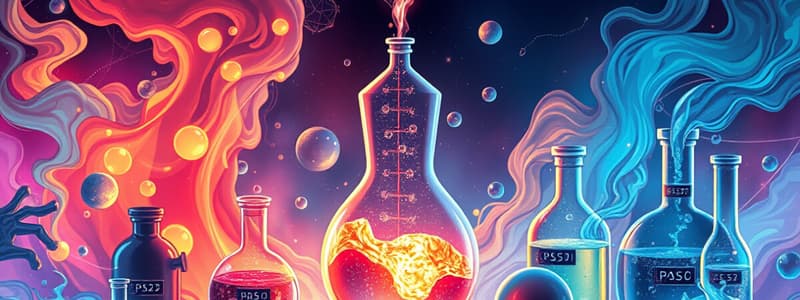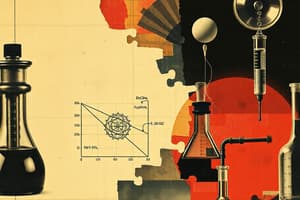Podcast
Questions and Answers
What is pressure defined as?
What is pressure defined as?
The force per unit area on a surface.
What is the definition of a Newton (N)?
What is the definition of a Newton (N)?
The force that will increase the speed of a one-kilogram mass by one meter per second each second that the force is applied.
What is a barometer used for?
What is a barometer used for?
To measure atmospheric pressure.
What is the common unit of pressure symbolized as mm Hg?
What is the common unit of pressure symbolized as mm Hg?
What is the value of 1 atmosphere of pressure (atm) in mm Hg?
What is the value of 1 atmosphere of pressure (atm) in mm Hg?
What is defined as the pressure exerted by a force of one newton acting on an area of one square meter?
What is defined as the pressure exerted by a force of one newton acting on an area of one square meter?
What are the standard conditions called for temperature and pressure in scientific comparisons?
What are the standard conditions called for temperature and pressure in scientific comparisons?
What is the partial pressure of a gas?
What is the partial pressure of a gas?
What does Dalton's Law of Partial Pressures state?
What does Dalton's Law of Partial Pressures state?
What are gas laws?
What are gas laws?
What does Boyle's Law state?
What does Boyle's Law state?
What temperature is referred to as absolute zero?
What temperature is referred to as absolute zero?
What does Charles's Law state?
What does Charles's Law state?
What does Gay-Lussac's Law state?
What does Gay-Lussac's Law state?
What does the Combined Gas Law express?
What does the Combined Gas Law express?
What does Gay-Lussac's Law of Combining Volumes state?
What does Gay-Lussac's Law of Combining Volumes state?
What does Avogadro's Law state?
What does Avogadro's Law state?
What is the Standard Molar Volume of a Gas at STP?
What is the Standard Molar Volume of a Gas at STP?
What does the Ideal Gas Law represent?
What does the Ideal Gas Law represent?
What is the Ideal Gas Constant (R)?
What is the Ideal Gas Constant (R)?
What does STP stand for?
What does STP stand for?
Flashcards are hidden until you start studying
Study Notes
Pressure and Units
- Pressure (P): Force per unit area on a surface, a key concept in gas behavior.
- Newton (N): Unit of force; 1 N increases the speed of a 1 kg mass by 1 m/s².
- Barometer: Instrument for measuring atmospheric pressure, essential for understanding weather patterns.
- Millimeters of Mercury (mm Hg): Common unit of pressure; 1 atm equals 760 mm Hg.
- Atmosphere of Pressure (atm): Standard atmospheric pressure, equivalent to 760 mm Hg.
- Pascal (Pa): Pressure unit; defined as the pressure from a 1 N force acting on 1 m².
Temperature and Conditions
- Standard Temperature and Pressure (STP): Defined as 1 atm and 0°C, used for gas comparisons.
- Absolute Zero: Theoretical lowest temperature (-273.15°C), assigned 0 K on the Kelvin scale.
Gas Behavior Laws
- Partial Pressure: Pressure exerted by individual gases in a mixture; crucial for calculating total gas pressures.
- Dalton's Law of Partial Pressures: States the total gas pressure equals the sum of partial pressures of all gases.
- Gas Laws: Mathematical relationships governing gas behavior regarding volume, temperature, pressure, and amount.
Individual Gas Laws
- Boyle's Law: For a fixed mass of gas, volume varies inversely with pressure at constant temperature.
- Charles's Law: For a fixed mass of gas at constant pressure, volume varies directly with Kelvin temperature.
- Gay-Lussac's Law: For a fixed volume of gas, pressure varies directly with Kelvin temperature.
- Combined Gas Law: Integrates Boyle's, Charles's, and Gay-Lussac's Laws to describe the relationship between pressure, volume, and temperature.
- Avogadro's Law: Equal volumes of gases at same temperature and pressure contain equal numbers of molecules.
Additional Concepts
- Gay-Lussac's Law of Combining Volumes of Gases: At constant temperature and pressure, gas volumes react in small whole number ratios.
- Standard Molar Volume of a Gas: Volume occupied by one mole of gas at STP; approximately 22.414 L.
- Ideal Gas Law: Relates pressure, volume, temperature, and moles of gas through a mathematical formula.
- Ideal Gas Constant (R): The constant used in the Ideal Gas Law; varies based on the units (e.g., mm Hg, kPa, atm).
STP Recap
- STP: Standard conditions for gas calculations; defined as 0°C and 1 atm pressure.
Studying That Suits You
Use AI to generate personalized quizzes and flashcards to suit your learning preferences.




